#neldoreth forest
Explore tagged Tumblr posts
Text

By Moonlight in Neldoreth Forest by Ted Nasmith
#lúthien#neldoreth#forest#forest of neldoreth#neldoreth forest#moonlight#art#lotr#lord of the rings#the lord of the rings#middle earth#jrr tolkien#tolkien#j.r.r. tolkien#ted nasmith
6K notes
·
View notes
Text

"By Moonlight in Neldoreth Forest" - Ted Nasmith.
805 notes
·
View notes
Text
When Melian returns to Aman, she returns as a stranger in a strange land.
Her time in Beleriand has changed the very essence of her spirit, and she quickly finds that Aman is no longer the same as when she'd first left.
Melian can no longer find beauty in the unchanging perfection of the Blessed Realm. Though the landscapes are lovely, there is always something missing.
She misses the rugged but natural, cavernous beauty of Menegroth. The sparkling, open cities of Tirion and Alqualondë are strange to her, with their many buildings that glitter in the sun. Both cities are lovely, but they're too perfect, too clean.
She misses the cool air of the forests of Doriath. Though the forests of Aman are lovely, they are too pristine, too perfect. They don't grow tall and wild like Nan Elmoth, and there's no sound of rushing water like there had been in Neldoreth.
She misses the nights of Beleriand. In Doriath, the forests always came to life, with fireflies drifting through the trees and crickets chirping alongside the songs of nightingales. Nights in Aman are too peaceful, too quiet, unless you were in Tirion or Alqualondë.
Melian struggles to fit in with the rest of the Maiar. Many of them cannot understand the emptiness she feels. Her time among the Children of Ilúvatar has changed her so much, she cannot go back to how she used to be.
She misses Elu Thingol, her beloved husband and life partner. She misses the Iathrim, the people she loved. She misses Lúthien, her only daughter, and Beren, her brave mortal son-in-law. She misses Dior, her willful and spirited grandson. And above all, she misses Doriath so much.
However, she doesn't regret her life in Middle-earth. She was able to be a wife, a mother, and a queen. She was surrounded by people who loved her, and she loved them all with every fiber of her being. She had a beautiful family of her own, and they were her greatest treasure.
And even after all of the sorrows and heartache, Melian knew that she would gladly live that same life again if she could.
#the silmarillion#silmarillion#melian#melian the maia#aman#valinor#doriath#sindar#jrr tolkien#tolkien#tolkien tag#elu thingol#thingol#elwe singollo#luthien#luthien tinuviel#beren#beren erchamion#dior#dior eluchil
142 notes
·
View notes
Text
#lotr#jrr tolkien#lotr books#lord of the rings#lotr poll#tolkien legendarium#the silmarillion#the hobbit#first age#third age#tolkien couples#lotr ships#meet cute#thingol x melian#finrod x beor#aegnor x andreth#beren x luthien#bilbo x thorin#aragorn x arwen#faramir x eowyn#arawen#farawyn#bagginshield
90 notes
·
View notes
Text

"Though Middleearth lay for the most part in the Sleep of Yavanna, in Beleriand under the power of Melian there was light and joy, and the bright stars shone as silver fires; and there in the forest of Neldoreth Lùthien was born, and the white flowers of niphredil came forth to greet her as stars from the earth."
-The Silmarillion, Of the Sindar
57 notes
·
View notes
Text
Named Woods of Beleriand
I���m in the process now of updating my geographic resources to make sure all information is accurate and as extensive as possible! Here is my Masterlist: Flora and Fauna of Arda
Please feel free to request any aspects of geography to go over! I’ll do non Beleriand locations too!
Christopher Tolkien’s Map of Beleriand can be found here Most locations mentioned can be found on it and the general regions can be found for those left out
Map Notes: Núath was not mentioned in the published Silmarillion and is not on Christopher’s map of Beleriand and the Lands to the North. It is however in the map in the back of The Children of Húrin. Alternately, while Nan Tathren DOES appear on Christopher’s map, it is not in the map in the Narn.
Arthórien: the easternmost forest that made up Doriath.
Brethil (”silver birch”, later called Sarch nia Chîn Húrin or the Grave of the Children of Húrin) was a forest in Western Beleriand, bordered by the river Sirion on the East and one of its larger tributaries, Taeglin along the West. It was considered part of the kingdom of Doriath however was not part of the Girdle of Melian and was later inhabited by descendants of the House of Haleth. Silver birches were the most common tree though I write a bit more about canonical flora as well as my own speculation here!
It has the dubious distinction of being the death site of Túrin, Niënor (though she was not buried there) and Morwen as well as the location where Húrin Thalion was imprisoned (again) and tried.* When Beleriand fell beneath the waves after the War of Wrath, the grave site of Túrin and Morwen remained partially above the water and was called Tol Morwen.
Nan Emloth (”Valley of star dusk”) was an Eastern Beleriand forest east of Doriath and near the river Celon, a tributary to the river Aros, itself a tributary to Sirion. It was somewhat North of Estolad. The trees here grew tallest of all of Beleriand and there was little to no sunlight. It was home to Eöl, originally from Doriath. It was also in Nan Emloth that Melian met Thingol and the two fell into an enchantment lasting years.
Nan Tathren, the Valley of willows, was in middle Beleriand, between East and West where the river Narog met the Sirion, north of the Mouths of Sirion and South of the Gates of Sirion. In the Book of Lost Tales, it was said that the flowered meadows of Nan Tathren was where all butterflies came into the world and though this was likely later struck from canon, it’s possible it remained as a story and butterflies were still abundant here.
Neldoreth is a forest of beech trees, part of Northern Doriath and contained within Melian’s Girdle. It was here that Lúthien was born and later imprisoned to prevent her from rescuing Beren. It was bordered by the River Esgalduin on the South and and River Mindeb on the West, both tributaries to Sirion. The tallest beech tree in the forest was Hírilorn and it was here that Lúthien was imprisoned.
Nimbrethil was a forest of birches in the realm of Arvernien on the Northern shores of the Bay of Balar. Wood from these trees were used to construct Vingilot, the ship of Eärendil. The forest was South of the river Narog and West of Sirion.
Nivrim was a forest of mostly oak trees and was the only part of Doriath contained within Melian’s Girdle that fell West of the River Sirion. It was North of the Twilight Meres. There was a guarded bridge that was built over Sirion, near where it met with its tributary Esgalduin, that connected it with the rest of Doriath.
Region is within Melian’s Girdle in Southern Doriath. It was populated mostly by holly trees and was where the kingdom of Menengroth was built. It was bordered by Aros on the South and Esgalduin to the North.
Taur-im-Duinath, the Forest between rivers, was a forest that lay between the rivers Sirion and Gelion. Gelion was the greatest of the seven rivers of Ossiriand and the only one that ran North to South. It was South of the Andram and East of the Bay of Balar. It was described as dark and gloomy and uninhabited save but for small, transient groups of Avari.
Taur-en-Faroth was a series of wooded hills in Western Beleriand west of the river Narog. They were part of the kingdom of Nargothrond.
Taur-nu-Fuin, Forest of Dread was the Southern part of Dorthonion after it fell under the rule of Morgoth after Dagor Bragollach. As I mentioned in my post about it, there are vivid descriptions in The Silmarillion, The Children of Húrin, and The Lays of Beleriand that name species that dwelt there.
The woods of Núath was a small forest South of the Ered Wethrin where the river Ginglith, a tributary to Narog, began.
21 notes
·
View notes
Text
I Read The Silmarillion So You Don't Have To, Part Five
Previous part: https://nyxshadowhawk.tumblr.com/post/728961431368761344/i-read-the-silmarillion-so-you-dont-have-to-part
Chapter 10: Of the Sindar Meanwhile, in Middle-earth…
Remember the Sindar? They’re the people of Elwë, the only one of the original three Elven Lords who never made it back to Valinor, and Melian, a Maia who seduced him. The Sindar are basically native to Middle-earth, and save for Elwë himself, none of them have seen the Two Trees of Valinor. That makes them “Grey Elves,” neither light nor dark. They live in Beleriand, the westernmost land mass of Middle-earth, on which most of The Silmarillion takes place, and which is completely gone by the time LotR takes place.

Elu Thingol by @bohemianweasel
The Sindar know Elwë as Thingol, which is Sindarin for “Greymantle,” and acknowledge him as king. Earlier, I assumed that Thingol and Melian were the ancestors of the Sindar, but this isn’t true; they only have one child, and her name is Lúthien. She is one of the other major players in The Silmarillion, and was based directly on Tolkien’s wife Edith, so she’s kind of a big deal. She’s born in the forest of Neldoreth, and white flowers spring up to greet her.
While Melkor was being held captive in Valinor, the Dwarves finally enter the picture in Middle-earth. They call themselves Khazâd, and the Sindar call them Naugrim, which means “stunted people.” The Elves are somewhat bewildered when the Dwarves come into Beleriand from the East, because they didn’t know that any other people existed. They assumed that they were the only living things who could speak or make things. They don’t learn the Dwarven language, but the Dwarves endeavor to learn Sindarin. When the Noldor eventually show up, the Dwarves really like them, because the Noldor share their reverence for the god Aulë and their skill at metalwork and cutting gemstones.
Because Melian is a Maia, she can see the future. She warns Thingol that the peace isn’t going to last. Thingol decides to build a fortress in case worst comes to worst, and enlists the help of the dwarves to build it. The Dwarves oblige, happy to have a new project, and Thingol pays them in pearls, which they’d never seen before. The biggest pearl is called Nimphelos, which the Dwarves particularly value. (Its name sounds a lot like Omphalos, an egg-shaped sacred stone at Delphi that the Ancient Greeks thought was the navel of the world.) The Dwarves build Thingol a mansion underground, in the style of their own. I’m guessing that, like Hobbit holes, this is a reference to Celtic fairy lore that describes fairies as living in mounds. Like the fairies of British and Irish lore, Thingol has a lavish underground palace called Menegroth, the Thousand Caves. Its pillars are carved to look like trees, with carved animals on the walls and in the “branches�� of the pillars. Colorful mosaics decorate the floors, banners and tapestries chronicle the deeds of the Valar, there are silver fountains and singing nightingales, and it’s all as beautiful as anything gets outside of Valinor.
Everything’s great for a bit, but Melkor’s monsters still exist, and eventually Orcs and wolves push into Beleriand. The Elves don’t know what the Orcs are. They assume that the Orcs are Avari (Elves that refused to go to Valinor) that turned evil, which is almost right in an indirect way. Thingol needs weapons to fight Melkor’s monsters, but the Sindar don’t have any weapons and don’t know how to make them, because they’ve never needed them before. The Dwarves know how to make them, having used them to fight all the dangerous things in the East, and they teach the Sindar how to make and use them. Dwarves remain the absolute best at making things of steel, and they invented chainmail.
Remember the Nandor? They were another subgroup of Elves who split off from the Teleri while they were traveling to Valinor, and stayed in Middle-earth. They become the Wood Elves, and their descendants will be the elves of Mirkwood. But at this point in history, they come to Thingol, seeking protection from Melkor’s monsters. Thingol lets them stay in an eastern land called Ossiriand.
A Sindar Elf named Daeron invents the runic writing system, which the Elves don’t care for, but the Dwarves readily adopt.
Once again, everything’s great for a while. But then, Morgoth and Ungoliant have their struggle to the north. The Sindar hear Morgoth’s shrieking and know that something is wrong. Melian’s magic keeps Ungoliant from entering their land, but barely. The Sindar are suddenly assaulted by Morgoth’s massive army of Orcs from his northern citadel of Angband. The Orcs aren’t like anything the Sindar have ever seen, and there’s thousands of them. We get a short summary of the ensuing battle (in which Tolkien drops more place names than I can possibly keep track of).
The Elves and Dwarves win, but they lose a lot of lives in the process. The King of the Nandor, an Elf named Denethor, dies in combat. Distraught by his death, many of his people renounce open war. They are called Laiquendi, “Green Elves,” because they wear leaves. The rest of the Nandor join the Sindar, and merge with them. The Sindar fence themselves into their forest with a magic wall of “shadow and bewilderment” that Melian casts to keep the Orcs out. After that, their forest becomes known as Doriath, the “Land of the Girdle,” after the magic wall. The wall protects them, but the peace and bliss are broken.

Chapter 11: Of the Sun and Moon and the Hiding of Valinor In which the Two Trees have a last hurrah.
Back in Valinor, the Valar are very sad about the Trees, but they’re even sadder about Fëanor. Fëanor is, without a doubt, the best of the Elves. He may be a narcissist, but he’s right about how great he is: he’s the strongest, the smartest, the cleverest, the most beautiful, the most skilled, and the most capable both mentally and physically. Imagine all the good he could have done in the world, and what beautiful and useful things he might have made, if Morgoth hadn’t corrupted him! Now he’s going to waste his life on a pointless endeavor, and his entire line is cursed. It didn’t have to be like this. When a messenger tells Manwë how Fëanor responded to the prophecy of doom, Manwë cries.
However, Manwë doesn’t dispute Fëanor’s boast that people will sing of his deeds until the end of the world. After all, songs are beautiful things. If you remember, Eru Ilúvatar told Melkor that all of his evil deeds will result in more beautiful things, that no one would otherwise have conceived of. Evil always begets good, in spite of itself. Fëanor’s evil deeds will result in the creation of beautiful art in the future, thus indirectly producing good things. But that doesn’t make Fëanor’s actions any better in the present.
Yavanna, goddess of plants, and Nienna, goddess of sorrow, do their absolute best to heal the Trees. The Trees are beyond saving, but the goddesses’ lamentation does do something: With their last bit of strength, Telperion bears a single silver flower, and Laurelin bears a single golden fruit. Yavanna picks them both off the trees. After that, the Two Trees die for good, with nothing but their lifeless stems remaining in Valinor as a sad monument to what once was. Manwë blesses the flower and the fruit, and Aulë makes vessels to hold and preserve them. Then Varda hangs them in the sky as the new lamps: The flower of Telperion is the Moon, and the fruit of Laurelin is the Sun. The two lights will help the Children of Ilúvatar and hinder Morgoth.
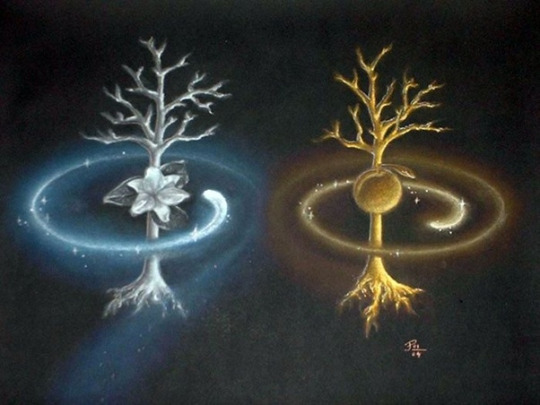
Creation of the Two Trees by Julia Pelzer
Each group of Elves has a different name for the Moon and the Sun. The Vanyar (the Elves who got to Valinor first and stayed there) call them Isil and Anar. The Noldor call them Rána the Wayward, and Vána the Heart of Fire.
The Moon and Sun also have their own Maiar to guide them through the sky. The Maia of the Sun is called Arien, and the Maia of the Moon is called Tilion. Both Maiar had loved their respective Trees while the Trees were alive, and begged for the position of tending to the Sun and Moon. Arien is a fire goddess who doesn’t fear the heat of the sun, and Tilion is a hunter god who was one of Oromë’s companions. (This mirrors Norse Mythology, in which the Sun is driven by a goddess called Sol or Sunna, and the Moon by a god called Máni.)

Narsilion by breath-art
The Moon rises first, and brings hope to the Elves. When the Moon rises, Fingolfin and the Noldor begin their long trek into Middle-earth across the frozen north. After the Moon rises and sets seven times, the Sun is hung in the sky, and the first dawn comes. When the Sun sets, it comes to rest in Valinor, briefly reminding the Valar and remaining Elves of the light of the Two Trees and the joy they once had. But the Sun and Moon still pale in comparison to the Two Trees. The only remaining things that preserve the original light, pre-Ungoliant’s destruction, are the Silmarils.
Morgoth is obviously horrified, and immediately sends dark clouds to prevent the Sun from shining upon his land of Angband. Arien, the Maia of the Sun, is the only entity that Morgoth is really afraid of, and he no longer has the strength to attack her. But he does send evil spirits after Tilion, the Maia of the Moon. (This might explain why the moon has phases, but it’s not explicitly said.)
The Valar still remember what happened the last time they put up lamps, and they’re not about to let Morgoth destroy their paradise for a third time. They decide to almost completely cut off Valinor from the rest of the world. They make the Pélori Mountains around Valinor rise impossibly high, with sheer faces like glass. The only way in or out of Valinor is through a mountain pass called the Calacirya, which the Valar leave open to allow the Elves to see the stars. But the pass is heavily guarded. And, as an extra precaution, they fill the sea with enchanted islands that are full of illusions to confuse and trap anyone who tries to sail to Aman. The Noldor are officially, permanently cut off from Valinor — there’s no turning back now.
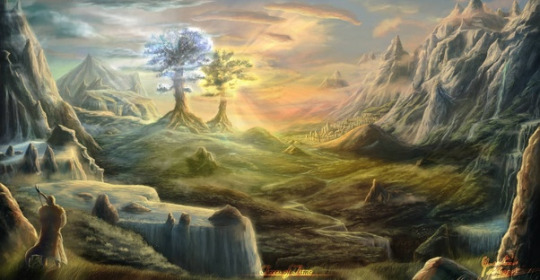
Telperion and Laurelin by MrSvein872
Chapter 12: Of Men In which the Men finally show up.
Having sealed themselves away, the Valar basically leave Middle-earth to the mercy of Morgoth. It’s not all bad, though; the Sun keeps Morgoth at bay, and it causes many new things to grow in Beleriand. Beleriand is a pretty nice place, for what it’s worth. Not as nice as Valinor, but, y’know… it could be worse.
When the Sun rises, the Men finally awaken. The Elves have a lot of different names for them, but the important ones are Atani (“Second People”) and Hildor (“Followers”). The Men didn’t have a Vala to invite them to Valinor. Men fear the Valar, because they don’t really know what the Valar are or why they’re there, and the Valar have stopped paying attention to Middle-earth. Ulmo watches over the Men through all the water of Middle-earth, but Men don’t know how to understand the divine messages brought to them by the water. It’s rumored that the Men befriend the Avari, the Dark Elves who never went to Valinor.
At the time, Men looked more like Elves than they do now. Men were taller, stronger, and longer-lived than they are now, but Elves were still prettier, wiser, and more skilled than Men. Elves are immortal, and do not sicken or age, but they can still be killed. Men have less robust bodies and are more prone to illness and injury. Dark Elves are better than Men, but the High Elves that saw Valinor are significantly better than both Dark Elves and Men. The only Dark Elves that come close to the greatness of the High Elves are the Sindar, and that’s only because their queen is a Maia.
The other big difference between Elves and Men is what happens after they die. When Elves die, they go to the Halls of Mandos and eventually reincarnate. The Elves don’t know what happens to Men after they die. If they go to the Halls of Mandos, they don’t go to the same part of them that the Elves go to. No one but Mandos and Manwë knows what happens to the Men after that. Only one Man ever came back from the dead (we’ll get there). It’s possible that the only entity that knows anything about what happens to Men after death is Ilúvatar himself.
The relationship between Elves and Men gets steadily worse with time, mostly because of Morgoth (again, we’ll get there). By the time of the Third Age, when LotR takes place, there are very few Elves left. They have retreated away from the sunlight, into lonely woods and caves, and “become as shadows and memories.” The Men take over from the Elves, and forget that the Elves ever existed. But the The Silmarillion is about the First Age, and back then, Elves and Men were friends. Some Men achieved greatness through learning Elven wisdom, and some Men even had children with Elves.
Chapter 13: Of the Return of the Noldor In which we return to the main plot, and a LOT of shit goes down.
Where we last left the Noldor, Fingolfin was leading them on an impossible journey across a frozen wasteland to cross into Middle-earth, because he saw Fëanor burn the boats on the opposite shore. Fëanor and his sons continued further into Middle-earth, and made a camp in the north.
Morgoth also saw Fëanor burn the boats. Even Morgoth was a little afraid of Fëanor, so he decides to preemptively attack Fëanor’s camp. Despite being taken by surprise, the Elves trounce the Orcs, because they still have the strength of Valinor in them. They’re strong and swift, with sharp and effective weapons, and the Orcs don’t stand a chance. A small handful of Elves — Fëanor, his seven sons, and their loyalists — slaughter an entire army’s worth of Orcs in only ten days. Morgoth’s plans for the conquest of Beleriand are ruined, for now.
Fëanor assumes that by chasing down the Orcs, he’ll find Morgoth. Fëanor is so impassioned, so ready to finally kick Morgoth’s ass, that he pats himself on the back for having defied the Valar. It was such a good idea to tell the Valar to go fuck themselves and come to Middle-earth! Now he gets the opportunity to personally take Morgoth down!
He spoke too soon. Fëanor promptly finds himself face-to-face with the fortress of Angband and an entire army of Balrogs. Oops.
Somehow, Fëanor manages to hold his own against multiple Balrogs, until Gothmog, the Lord of the Balrogs, nearly kills him. He only survives because his sons arrive at the last minute with reinforcements to fend off the Balrogs.
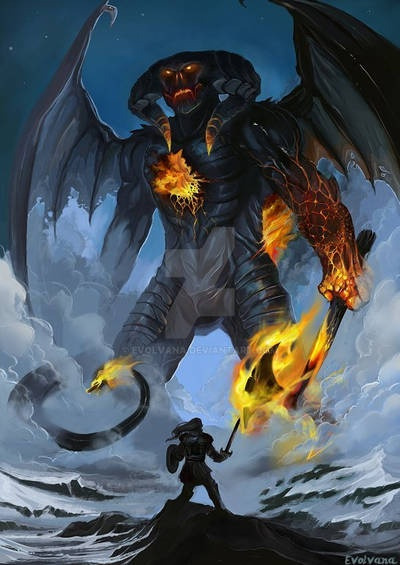
Fëanor against the Lord of the Balrogs by Evolvana
Fëanor doesn’t live for much longer, though. His sons start to carry him back to their camp, but he bleeds out on the way. He curses Morgoth and tells his sons to avenge him with his dying breath. As his spirit leaves him, his body burns to ash, because his soul is just that fiery. And that’s it — Fëanor, the mightiest Elf to ever live, is dead. His curse means that his soul is forever trapped in the Halls of Mandos, and he will never reincarnate. No one like him will ever appear in Arda again.
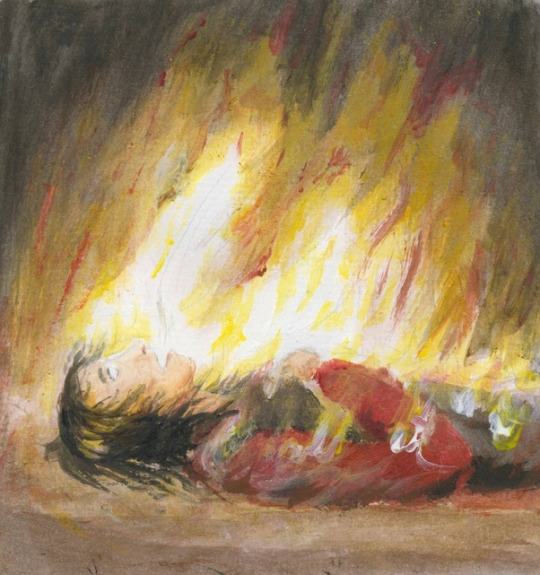
The Death of Curufinwe Feanaro by Gwenniel
Honestly, I’m surprised that Fëanor dies this early. I thought he was the central character, but I’m still only about a third of the way through, maybe less.
Despite having taken out Fëanor (mostly due to Fëanor’s own arrogance and impulsiveness), Morgoth still lost badly. He sends an envoy to Fëanor’s sons, acknowledging defeat and requesting a ceasefire, even offering to surrender a Silmaril. Fëanor’s eldest son, Maedhros (MY-thros, ‘th’ as in “this”) takes over from Fëanor as the leader of the Noldor. Maedhros doesn’t trust Morgoth as far as he can throw him, but decides to go to the negotiation anyway, with backup. Of course it’s an ambush, and there are Balrogs. All of Maedhros’s backup are killed, and Maedhros himself is captured and taken to Angband.
Fëanor’s other sons build themselves a mighty fortress, but Morgoth keeps Maedhros hostage until the Noldor agree to end the war and leave Beleriand. The sons of Fëanor doubt that Morgoth will keep his word on that. They also literally can’t stop fighting Morgoth, because of their oath. So, Morgoth hangs Maedhros by the wrist from the face of the Thangorodrim Mountains. The only remaining option is to try to rescue him.

Maedhros Upon Thangorodrim by Jenny Dolfen
Back with Fingolfin, the rest of the Noldor painstakingly make their way across the land bridge. It’s an agonizing journey, and many Elves die, but when the first dawn finally comes, Fingolfin unfurls his banner and blows his horn in victory. The ice starts to melt, and flowers spring up under his feet. The Sun chases Morgoth to the depths of his citadel, so he doesn’t harass Fingolfin’s group as they arrive in Middle-earth.

Helcaraxe by Stefan Meisl
Fingolfin is wiser than Fëanor, and doesn’t try to attack Angband. Instead, he tries to find the other Noldor. Most of his Fingolfin’s group really hate Fëanor and his sons, because it’s their fault that they nearly froze to death. So, they make their own camp near Lake Mithrim.
Fëanor’s group hears of their arrival. They’re astounded and impressed that Fingolfin and co. managed to survive, and that they made it to Middle-earth. They would welcome Fingolfin’s group, but they’re too ashamed to offer. Too little, too late.
Fingon, Fingolfin's son, decides to try to heal the relationship between the two groups of Noldor. He recognizes that Morgoth would be thrilled if his enemies were so divided against themselves. If they want to stand a chance against Morgoth, they have to unite. Fingon has the perfect idea for how to bring the two groups together. He was very close to Maedhros. He doesn’t know that Maedhros wanted to go back for him when Fëanor burned the ships, so, he assumes that Maedhros betrayed him. Even so, he still cares enough about Maedhros to want to try to rescue him.
He climbs the mountains of Thangorodrim by himself, hidden under the cover of the darkness that Morgoth created to shut out the sun. Then, Fingon takes out a harp and starts singing. He sings a song from Valinor, from long before the unrest took hold. His voice rings throughout the mountains, in which there had never been singing before. He sings in defiance of Morgoth like the Whos singing in defiance of the Grinch on Christmas Day.

He Sang a Song of Valinor by Jenny Dolfen
Faintly, he hears an answering voice singing the same song. Maedhros is singing, despite his suffering. Fingon climbs up to where Maedhros hangs, and cries when he sees how much pain Maedhros is in. Maedhros has long since given up hope, and begs Fingon to shoot him, to put him out of his misery. Fingon prepares to shoot an arrow, but says a prayer to Manwë, asking him to have mercy.
Fingon’s prayer is answered. Manwë sends the King of the Eagles, Thorondar, who picks up Fingon and carries him up the mountain face to where Maedhros hangs. Fingon can’t find any way to open or break the shackle that holds Maedhros, and can’t detach it from the mountain face. Maedhros again begs Fingon to kill him, but Fingon figures that it’s better to lose a hand than to die. Fingon cuts off Maedhros’ hand, and Thorondar catches him, carrying both Elves back to Lake Mithrim.
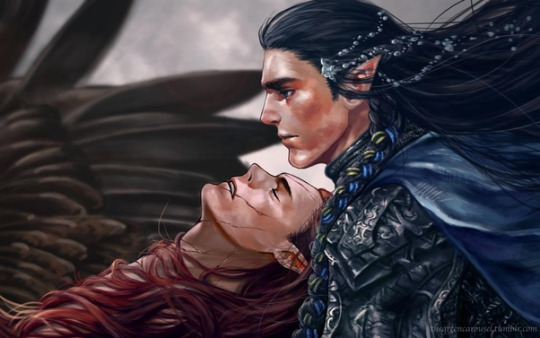
Flight from Thangorodrim by @thegreencarousel
(As you can probably guess, a lot of Silm fans ship Fingon and Maedhros. I almost did, too… and then I remembered that they’re first cousins.)
After that, the rift between the two groups of Noldor is healed. Fingon is hailed as a hero by both groups of Noldor. Maedhros steadily gets better, and recovers his strength. He pulls and Inigo Montoya and learns to wield a sword just as well with his left hand. He also waives his claim to kingship over the Noldor. He begs Fingon to forgive him for having deserted him back when Fëanor burned the boats, and tells Fingon that he’s the rightful heir of the House of Finwë. That’s a nice gesture, but it’s actually part of the curse — The House of Fëanor became known as the Dispossessed, because even though they’re the older brother’s children, they permanently lost the rulership of the Noldor.
The now-united Noldor decide to explore Beleriand a little more, and they eventually meet the Sindar. The Noldor and Sindar recognize each other as kin, but have a hard time understanding each other because they speak different languages. Eventually, they figure out a way to talk to each other. The Noldor learn about King Thingol and the magic wall around his kingdom of Doriath, and about the Sindar’s battles with the Orcs. The Sindar are delighted that these stronger, smarter elves from Valinor arrived right when they were most needed, and assume that the Valar must have sent them.
Thingol is less enthused about a bunch of hotheaded foreign princes arriving in his land. The only Noldor he trusts to let past the magic wall are Finarfin’s children: Finrod, Angrod, Aegnor, and Galadriel. This is because their mother was Eärwen, one of the Teleri Elves and Thingol’s niece. So, they’re his closest relatives among the Noldor. Angrod is the first of the Noldor to enter Thingol’s palace in Doriath. He tells Thingol all about what happened to the Noldor in the North — how they crossed over, how many of them there are, how they beat back Melkor’s forces, how Finrod saved Maedhros, etc. He leaves out the part about the kinslaying and the curse.
Thingol gives the Noldor his blessing to remain in the northern part of Beleriand, but they can’t displace the Sindar from their homes. They also aren’t allowed to come past Doriath’s magic wall, unless they’re invited, or if they desperately need an audience with Thingol. Thingol is Lord of Beleriand and the Noldor are imposing upon him, so, they’re in no position to argue.
When Angrod brings this message back to the Noldor, Maedhros straight-up laughs. “What kind of king is he? These aren’t his lands. He doesn’t have the power to grant us leave to live here, as if we were his vassals. If it weren’t for us, there’d be Orcs breaking down his door.”

Maedhros by _star热爱生活呀巴扎嘿
Caranthir, another one of Fëanor’s sons who inherited his father’s fiery temper, also doesn’t like Thingol’s conditions. “Who’s idea was it to send Finarfin’s sons as our spokesmen? I don’t trust a word they say, and I don’t trust this cave-dwelling Dark Elf. Finarfin’s sons should remember that, whoever their mother was, their father was still a Noldo — they should be loyal to the Noldor.”
Angrod is furious at this, and storms out. Maedhros chides Caranthir for going too far. The rest of the Noldor are all concerned that Fëanor’s whole family appears to be a ticking time bomb. It’s only a matter of time before one of them snaps and causes violence. Maedhros reads the room, and manages to get his brothers under control. He decides that he and his brothers should leave before things get worse. Not just leave the meeting, but leave the region — it’s better that they and the other Noldor remain friends at a distance, rather than risk another confrontation that tears them apart from within.
Maedhros and his brothers head east. Their new home is more exposed, and has less natural defense against Angband, but Maedhros doesn’t mind this. He and his brothers can be a buffer for the rest of the Noldor if Morgoth attacks again. And of course, the curse is still in effect.
Caranthir and his people are the first to find the Dwarves, who had stopped coming into Beleriand ever since the battle against Morgoth. You’d think that the Dwarves and the Noldor would have a lot in common, since both love to make things from metals and gems, and they both appreciate good craftsmanship. But nope. The Dwarves are too secretive, and Caranthir is too arrogant. He doesn’t even bother to hide that he thinks the Dwarves are ugly, and all his underlings follow suit. Despite that, the Dwarves and Caranthir’s Elves have a common enemy in Morgoth, so, they form an alliance anyway. From that alliance, Caranthir ends up learning a lot of Dwarven secrets about metalworking and masonry. It’ll really pay off for him in the future.
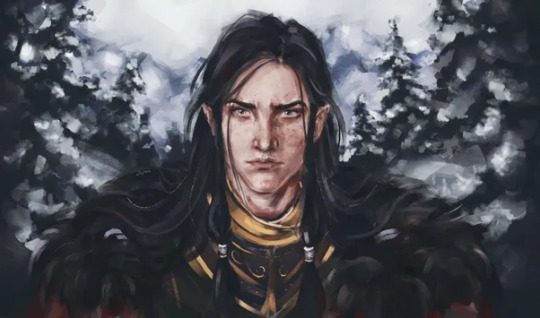
Caranthir by Miyota
Twenty years pass since the Sun first rose, and Fingolfin decides to throw a feast to unite all the scattered Elves. This feast is such a big deal that it has a name — Mereth Aderthad, the Feast of Reuniting. It’s a last moment of joy and happiness before everything goes to hell again. A number of Sindar attend the feast as well, alongside their leader, an Elf called Círdan (you’re gonna want to remember him). Thingol does not leave his magically-fortified palace, but he sends two diplomats to the feast — Daeron, the Elf that invented runes, and another called Mablung. There are even some Green Elves from the easternmost part of Beleriand. The main language spoken at the party is Sindarin, because the Noldor have had an easier time learning it than the other Elves have had of learning Quenya. All the Elves are on good terms with each other, and everything is great for a while. The Noldor begin to think that maybe Fëanor was right about Middle-earth being a good place for them.
Another thirty years pass. Turgon (Fingon’s brother and a son of Fingolfin) meets up with Finrod (a son of Finarfin). Together, they travel southward on the River Sirion, just to get away for awhile. They sleep on the riverbank, and Ulmo (the Vala of water) sends them a dream. Neither of them remembers the dream, only that it was troubling, and neither realizes that they had the same dream. After that, they’re both burdened with a sense of unease. Troubling dreams can only mean one thing — Morgoth is going to become a problem again. Turgon and Finrod independently decide that it’s a good idea to prepare for the worst.
Finrod and Galadriel, his sister, are briefly guests of King Thingol in Doriath (being two of the few Noldor whom Thingol would allow past the magic wall). Finrod is very impressed by the majesty of Menegroth, the king’s underground palace. He wants his own underground palace just like it, and tells Thingol as much. Thingol could have said, “no, how dare you copy me,” but instead he tells Finrod about a secret place in his realm — there’s a gorge in the River Narog, the river to the west of the Sirion, where there’s a cave complex that Finrod can use to build a palace.
Enlisting the help of some Dwarves, Finrod builds his palace, Nargothrond. He gives the Dwarves treasures from Valinor to thank them. The Dwarves are so impressed with the jewels that they make Finrod a beautiful necklace called the Nauglamír, which is said to be the finest work of the Dwarves in the First Age. It’s set with many, many gemstones from Valinor, but it’s as light as spider silk. The Dwarves are also grateful to Finrod for giving them an excuse to build another cool cave palace. They give him an epithet in their own language, Felegund, which means “Hewer of Caves.” Only a really cool Elf appreciates caves so much that he asks for his own cave palace.

Finrod by _star热爱生活呀巴扎嘿
Galadriel decided to stay in Thingol’s court, instead of following her brother to Nargothrond. She happened to meet one of Thingol’s relatives, a certain Sinda named Celeborn, and fell in love with him. Staying with Celeborn gave Galadriel the opportunity to study at the feet of Melian herself. So, if you’re wondering where Galadriel gets her wisdom and power from, it’s because she learned directly from a Maia.
Meanwhile, Turgon is feeling homesick for Valinor. He remembers the city of Tirion on its hill, with its silver tree (not the Silver Tree, one of its descendants). When he returns home, Ulmo personally appears to him, and tells him to go to the Vale of Sirion. He finds a hidden valley surrounded by mountains, in the center of which is a hill. It’s the perfect place to establish a New Tirion.
Throughout all this, Morgoth has been carefully observing the Noldor’s activities, and judging their strength. As soon as the Noldor are too distracted by city-building to prepare for war, Morgoth strikes. The Orcs are still a lot weaker than the Elves. Fingolfin and Maedhros chase the new Orc army all the way back to Angband. They kill every last one, within sight of Angband’s gates. But remember, Morgoth is a Vala, and has more up his sleeve than simply Orc armies. He causes earthquakes, fires, and volcanic eruptions. The Elves realize that there’s only one thing to do: cut the threat off at its source. They lay siege to Angband, and this siege lasts a full four hundred years.

Angband by gresetdavid
The Orcs are so afraid of the Noldor that they don’t leave Angband. Fingolfin boasts that the only way Morgoth could score a point against them is if the Noldor commit treason amongst themselves, which sounds a lot like tempting fate. Despite his confidence, the siege is a failure. Four hundred years, and the Elves don’t get any closer to capturing Angband, let alone taking back the Silmarils. Morgoth can still send spies out the back way, because the Elves can’t climb the snowy Thangorodrim Mountains. He captures Elves alive, and terrifies them so much that they do his bidding without having to be forced. He also looks for opportunities to sew dissent amongst the Noldor. It worked once, so it can work again.
A hundred years into the siege, Morgoth tries to capture Fingolfin. He knows that Maedhros isn’t about to let himself get captured again, and taking out the king would be an advantageous move. So, Morgoth sends a bunch of Orcs to sneak towards the Elves’ camp using the back way, through the same frozen mountain pass that Fingolfin used to get into Middle-earth. Morgoth should know at this point that Orcs are no problem for Elves. Fingon notices the Orcs, and slaughters them. This battle doesn’t even count as one of the “great battles,” because there aren’t enough Orcs for it to be notable. After that, there’s an interlude of peace that lasts for many years.
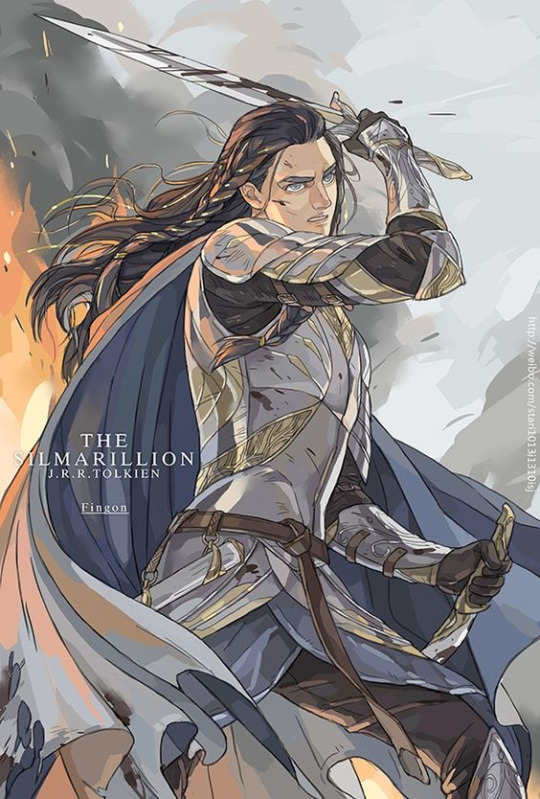
Fingon by _star热爱生活呀巴扎嘿
Morgoth finally gets the memo that he’s not going to beat the Elves by throwing Orcs at them. So, he tries a new tactic: A fucking dragon! If you think Smaug is bad, he’s a little baby lizard in comparison to Morgoth’s dragons. This one is called Glaurung (“gold worm” in Sindarin), and it’s a fat worm-like thing with a mouth of sharp teeth and fire breath. Glaurung is a young dragon, so, he mostly just thrashes around destroying fields and so forth. But he sufficiently terrifies the Elves.
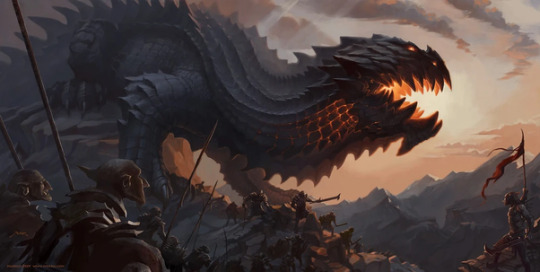
Glaurung by Vaejoun
Fingon isn’t afraid, though, and takes a band of archers to pummel Glaurung with arrows. Glaurung’s armored scales haven’t fully developed yet, so the arrows drive him crawling back into Angband. Fingon is endlessly praised by the Noldor for having defeated the dragon, and Morgoth is kicking himself for having shown his hand too soon.
After Glaurung’s defeat comes the Long Peace, which lasts two hundred years. In that time, the Elves have the opportunity to build beautiful cities and write books of lore and create other art. (This time is called the “Long Peace” because Morgoth doesn’t make any attacks, but presumably, the Siege of Angband is still going on.) The Noldor and Sindar also intermix, becoming more like one society, though the biological and cultural differences between them remain: The Noldor are still smarter and stronger, wiser, better warriors, and they like living in stone buildings. The Sindar have better singing voices, and are better musicians in general, and like living in the woods. Some Sindar are nomadic and wander around Beleriand, singing as they go.
*whew.* That’s it for this section.
Next part.
#the silmarillion#silm#the silm fandom#silmarillion#silm art#summary#the lord of the rings#lotr#feanor#fëanor#fingolfin#maedhros#fingon#finrod#thingol#the noldor#the sindar#morgoth#jrr tolkien#tolkien#middle earth#elves#tolkien elves#silm elves#beleriand#angband
66 notes
·
View notes
Text
Silmarillion Daily - Of Menegroth
Today’s Silmarillion Daily contains two events - one is the building/carving of Menegroth and the other, happening around the same time in Valinor, is the births of Turgon and Finrod.
Here’s the part on Menegroth:
Now Melian had much foresight, after the manner of the Maiar; and when the second age of the captivity of Melkor had passed, she counselled Thingol that the Peace of Arda would not last forever. He took thought therefore how he should make for himself a kingly dwelling, and a place that should be strong, if evil were to awake again in Middle-earth; and he sought aid and counsel of the Dwarves of Belegost. They gave it willingly, for they were unwearied in those days and eager for new works; and though the Dwarves ever demanded a price for all that the did, whether with delight or with toil, at this time they held themselves paid. For Melian taught them much that they were eager to learn, and Thingol rewarded them with many fair pearls. These Círdan gave to him, for they were got in great number in the shallow waters about the Isle of Balar; but the Naugrim had not before seen their like, and they held them dear. One there was as great as a dove’s egg, and its sheen was as starlight on the foam of the sea; Nimphelos it is named, and the chieftain of the Dwarves of Belegost prized it above a mountain of wealth.
Therefore the Naugrim laboured long and gladly for Thingol, and devised for him mansions after the fashion of their people, delved deep in the earth. Where the Esgalduin flowed down, and parted Neldoreth from Region, there rose in the midst of the forest a rocky hill, and the river ran at its feet, There they made the gates of the hall of Thingol, and they built a bridge of stone over the river, by which alone the gates could be entered. Beyond the gates wide passages ran down to high halls and chambers far below that were hewn in the living stone, so many and so great that that dwelling was named Menegroth, the Thousand Caves.
But the Elves also had part in that labour, and Elves and Dwarves together, each with their own skill, there wrought out the visions of Melian, images of the wonder and beauty of Valinor beyond the Sea. The pillars of Menegroth were hewn in the lines of the beeches of Oromë, stock, bough, and leaf, and they were lit with lanterns of gold. The nightingales sang there as in the gardens of Lórien; and there were fountains of silver, and basins of marble, and floors of many-coloured stones. Carven figures of beasts and birds there ran upon the walls, or climbed upon the pillars, or peered among the branches entwined with many flowers. And as the years passed Melian and her maidens filled the halls with woven hangings wherein could be read the deeds of the Valar, and many things that had befallen in Arda since its beginning, and shadows of things that were yet to be. That was the fairest dwelling of any king that has ever been east of the Sea.
And when the building of Menegroth was achieved, and there was peace in the realm of Thingol and Melian, the Naugrim yet came ever and anon over the mountains and went in traffic about the lands; but they went seldom to the Falas, for they hated the sound of the sea and feared to look upon it. To Beleriand there came no other rumour or tidings of the world without.
There’s another tidbit about Menegroth in History of Middle-earth (The Peoples of Middle-earth, “The problem of Ros”):
…the great Hall of the Throne of Elwë in the midst of his stronghold of Menegroth…was called the Menelrond [heaven-dome], because by the arts and aid of Melian its high arched roof had been adorned with silver and gems set in the order and figures of the stars in the great Dome of Valmar in Aman, whence Melian came.
The section further states that Elwing named Elrond in memory of this place, and that this was held to be prophetic, as it foreshadowed Elrond choosing the kindred of the Eldar and “carrying on the lineage of King Elwë [Footnote: Also also that of Turgon; though he oreferred that of Elwë, who was not under the ban that was laid on the Exiles.]”, while Elros, named for water, crossed the seas and became King of Númenor.
I feel like Menegroth in the passage above comes about as close as anything else we see to Eru’s ideal for the Ainur and the Eruhíni: dwarves and elves and a Maia all working together in Middle-earth to make something beautiful with their different skills and knowledge. The decision to do it in incited by the awareness of danger, but that leads not to hostility but to cooperation and beauty. It’s not in Valinor, but it recalls much of Valinor and of the Valar: the carvings of trees and woodland creatures recall the forests of Oromë, the nightingales the gardens of Lórien, the tapestries of history (and visions of the future) the halls of Vairë and Mandos. Different peoples get a glimpse of things they don’t fully understand, but are drawn to: the dwarves can’t stand the sea, but they nonetheless love Círdan’s pearls.
This is what makes the way Menegroth ends such an absolute tragedy, and it is what makes Legolas and Gimli in The Lord of the Rings the redress of that tragedy: their visits to Aglarond and Fangorn, each understanding what the other loves, is a kind of echo of the unity of these caverns carved with trees and forest-creatures. They’re putting things right. (As, in a different way, Galadriel is putting Fëanor’s story right, and Elrond is putting Thingol’s specifically right.) Not putting things back exactly as they were, but healing them.
#i feel like this passage gets so overlooked#because “of the sindar” is a big flashback dropped in the middle of the return of the noldor#i like being able to see these sections in their chronological place#silmarillion daily#the silmarillion#tolkien#the lord of the rings#thingol#melian#dwarves#legolas#gimli#doriath
48 notes
·
View notes
Text
Upon Doriath a heavy change had fallen. Melian sat long in silence beside Thingol the King, and her thought passed back into the starlit years and to their first meeting among the nightingales of Nan Elmoth...For Melian was of the divine race of the Valar, and she was a Maia of great power and wisdom; but for love of Elwë Singollo she took upon herself the form of the Elder Children of Ilúvatar, and in that union she became bound by the chain and trammels of the flesh of Arda. In that form she bore to him Lúthien Tinúviel; and in that form she gained a power over the substance of Arda, and by the Girdle of Melian was Doriath defended through long ages from the evils without. But now Thingol lay dead, and his spirit had passed to the halls of Mandos; and with his death a change came also upon Melian. Thus it came to pass that her power was withdrawn in that time from the forests of Neldoreth and Region, and Esgalduin the enchanted river spoke with a different voice, and Doriath lay open to its enemies.
The Silmarillion, Of the Ruin of Doriath, JRR Tolkien
#thingol#melian#thelian#the silmarillion#tolkien tag#chaos of the abyss reminded me of this quote#thelian feelings
7 notes
·
View notes
Text
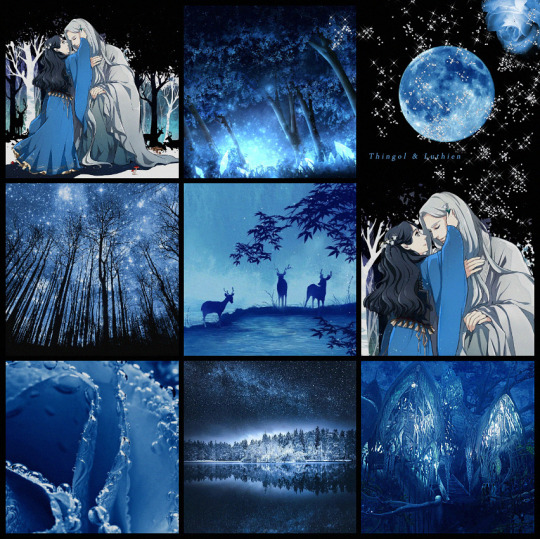
The Silmarillion aesthetic | Thingol and Luthien And at the end of the first age of the Chaining of Melkor, when all the Earth had peace and the glory of Valinor was at its noon, there came into the world Within, the only child of Thingol and Melian. Through Middle-earth lay for the most part in the Sleep of Yavanna, in Beleriand under the power of Melian there was life and joy, and the bright stars shone as silver fires; and there in the forest of Neldoreth Luthien was born, and the white flowers of niphredil came forth to great heroesstars from the earth.
Beautiful art Thingol and Luthien by Sandoakato
#thingol#luthien#silmarillion aesthetic#middle earth#tolkien#doriath#sindar elves#aesthetic#moodboard#silmedit#my edit
100 notes
·
View notes
Text

View the full art by @bloodwingblackbird here!
from flowering niphredil
- a @tolkienrsb fic by ohboromir (@maironsbigboobs)
and there in the forest of Neldoreth Lúthien was born, and the white flowers of niphredil came forth to greet her as stars from the earth Lúthien, and how the world sees her.
Rating: Teen
Word Count: 7015
Archive Warning: No Archive Warnings Apply
Categories: Gen & F/F
Relationships: Lúthien & Melian ,Thingol & Lúthien, Galadriel/Lúthien, Galadriel & Lúthien
Additional Tags: Character Study, Light Luthien/Galadriel
16 notes
·
View notes
Note
🍁+✨ for Doriath?
(Unusual headcanons ask game)
✨ - Worldbuilding or background story elements.
It wasn't just Menegroth and trees! There were lots of scattered villages, trading posts, towns, arguably several semi-independent cities within the Girdle. Many of the ones in Neldoreth had massive population growth after the Bragollach as refugees from the north poured in, only to have a sudden population drop as Carcharoth rampaged through.
They were often minimally-defended, as marchwardens patrolled the borders, the main army was encamped in Menegroth, and the Girdle took care of everything that mattered (besides giant wolves) until it didn't.
The dwarven and Feanorian armies left none alive as they cut through Region. Neither wanted word of their approach reaching Menegroth until it was too late.
🍁 - Physical locations, flora & fauna.
Arthórien/Radhrim (the blob of forest between Rivers Aros and Celon), where many of Denethor's folk who joined Thingol's people after the First battle settled, had a real problem with invasive cats after Men settled in Estolad next door. Now I'm not saying that Amrod and Amras, technically the Lords of Estolad, stole Men's cats and ferried them across the river and pushed them towards the Girdle but no actually that's exactly what I'm saying.
21 notes
·
View notes
Text
The legacy of Beren and Lúthien has the biggest impact on Elven pop culture— an impact that no other Elf/Man couple can even beat. Like, even the Elves in Aman are getting in on this hot new trend.
Horny paintings with so many variations of their first meeting— usually with a shirtless muscular Beren and a scantily-clad Lúthien swooning in his arms. Elven teens writing fanfiction about Beren and Lúthien— probably a lot of spicy stories about their time in Neldoreth. Beren becoming a sex symbol among Elf maidens, who are dreaming of finding their own hunk of a mortal man to fall in love with. Gay Elven lords thirsting after Beren and wanting a rugged mortal man to rail them into their beds. A small faction of Elven fangirls who ship Beren and Finrod because they’re “so hot” together. Fandom wars between Beren/Lúthien shippers and Beren/Finrod shippers. Color-coded couples’ jewelry inspired by Beren and Lúthien. In Aman, Oromë’s wolfhounds become hugely popular. So many Elven parents complaining about their daughters wanting to run away and find true love with hairy mortal men in forests. Vanyarin scholars spending decades dissecting the themes and motifs of the Lay of Leithian. A popular Telerin author writing an “erotic retelling” of the Lay of Leithian, which has so many spicy scenes that it becomes both popular among younger readers but also scandalous among said readers' parents. Finrod being the biggest Beren/Lúthien shipper of all time— he paints some of the horniest artworks, commissions a Vanyarin playwright to write a play about the Lay of Leithian, creates jewelry to match the aesthetics of Beren and Lúthien. He’s the captain of the Beren/Lúthien ship and no one else can hope to take his place.
All the reembodied Doriathrim are stunned at how popular Beren and Lúthien are. Melian kind of just takes it in stride. Thingol genuinely doesn’t know what to make of it— yes, he loves them both very much, and he's glad that his daughter is remembered among the Elves of Aman but he does NOT need to see a horny painting of his own daughter and son-in-law, thank you very much!
#the silmarillion#silmarillion#silm meta#beren and luthien#lay of leithian#beren erchamion#luthien tinuviel#beren#luthien#finrod#finrod felagund#valinor#aman#elu thingol#thingol#melian#elwe singollo#jrr tolkien#tolkien#tolkien tag
145 notes
·
View notes
Note
Galadriel/Celeborn and 6 and Andreth/Aegnor and 17. DNWs- Hurt no comfort, smut, graphic violence, angst
One more Holiday Silm Prompt fill for @greyjedijaneite with Celeborn and Galadriel. They were so much fun to write 🤩
Celeborn expects his first meeting with the golden Noldo princess to be a tense diplomatic ordeal. He’s quickly proven wrong. Featuring vine climbing, bird eggs, and other shenanigans.

crowned with the Sun
Celeborn assesses the outfits he has narrowed down for the King’s reception, to which he will be arriving late given how long he took to bathe, oil his hair, and perfume his body with sweet sage. He dismisses the overly formal dark blue robe that on a second glance seems more fit for a council discussion. He would not like the Noldo princess to think him a prude. The festive kaftan in red and yellow lined with silk won’t do either, saving him from leaving the impression that he is overly eager to receive these foreigners into their land.
He is certainly not pleased by the idea that some among the Noldor are now permitted to cross the borders of the Girdle as they please. It troubles him that they have come to Beleriand at all, stirring matters in the North and provoking Angband’s wrath.
But he does not intend to demonstrate his displeasure openly. King Thingol asked him to serve as a guide to Eärwen’s daughter and pry from her news from their long-parted kin in the Western Lands, and Celeborn is determined to be an archetype of Iatrhim hospitality. Besides, if the Noldor mean to stay in Beleriand, it would be wise to establish positive diplomatic relations early. Keep your friends close, and enemies even closer, as the elders say.
Celeborn settles at last for a comfortable coat in soft green elegantly embroidered along the sleeves with the trees of Neldoreth, the pride of Doriath. He catches his tresses in a loose ponytail between a hair clip in the shape of a nightingale’s beak aiming for a spontaneous appearance that should conceal the amount of effort he put into this look.
On the way to the Menelrond, Celeborn repeats to himself the schedule he carefully planned to entertain a representative of these war-like people come from across the Sea. By the time he arrives, Daeron’s flute is already filling the king’s hall with pleasant notes that match the mood of the Elves conversing merrily.
He spots her instantly.
Amid the colorful crowd of intricate braids and floor-trailing robes resembling the feathers of birds from the southern forests, the princess of the Noldor stands out in her modest leather leggings and light sleeveless tunic, her unbraided hair her only adornment. For all the simplicity, her beauty outshines the splendor around her.
But Celeborn won’t allow himself to be distracted by her proud nose and the sharp lines of her jaw as carved from fine marble. He inhales and strides across the hall with pride and assurance, a brilliant smile painted across his face.
‘Be welcome to Menegroth, my lady. I am Celeborn of the house of the King, and have the pleasure of serving as your guide through our fair lands,’ he says, forcing himself to slow down the words that try to rush out of his mouth.
‘The pleasure is all mine! Lúthien spoke highly of your person. Artanis I am known among my father’s people and Nerwen among my mother’s, the Falmari of Aman, our shared kin.’
Artanis Nerwen towers above him as she introduces herself, fixing the intense light of her eyes at him, though her voice flows gently as a playful stream across the forest floor. Celeborn clears his throat to refocus himself on the task at hand. ‘Will the lady care to join me for a walk? We have much to show that might please you.’
The confirmation comes in a smile with teeth as white as pearls and they begin their tour through the caves. Celeborn directs them first to the Hall of Guardians where many of the weapons of famed Marchwardens hang on the walls. It is the first of many strategic steps on this guided visit – let the Noldor see that Doriath is not passive in the war against their foe.
‘These bows were crafted from the wood of many ancient trees for Beleg Cúthalion over the years and the latest one, Belthronding, he still uses to defend our borders,’ Celeborn explains, watching how his companion runs a finger along the smooth bodies of the bows with wonder.
‘And this spear,’ he points to a steel-gray wooden weapon, ‘was carved by Mablung the Chief captain of King Thingol from a branch of Hírilorn, the heart of Neldoreth.’
At that, Artanis’ face alights, ‘Hírilorn! Oh, I have been dying to ask since I arrived! Pray tell, how does it get pollinated?’
Celeborn feels his eyebrows furrow in confusion. ‘The tree?’
‘Well, yes,’ Artanis continues, ‘the pollination of beech trees is performed by the winds, is it not? I have heard that the Girdle disrupts the flow of currents to prevent the deadly frosts incoming from the Iron Mountains. So how do the beeches reproduce in the absence of natural winds?’
‘Our Queen Melian summons the flight of nightingales, and their wings help stir the flowers of the trees. We also stimulate pollination across the mixed forests with song and flute,’ Celeborn expounds enthusiastically, despite himself.
‘Fascinating!’ Artanis claps her hands as if she has suddenly found the clue to a great riddle.
Mablung’s spear entirely forgotten, Celeborn beckons his guest to follow him to the pools where water emerges from silver fountains and leaps joyfully into basins of pink marble. The Noldor may be famed for their craft, but that won’t stop Celeborn from flaunting Menegroth’s architecture. The greatness his people have achieved without the aid of the Valar even!
Celeborn is more than pleased to see how Artanis is pointing her ears in all directions to catch the pleasant sounds around them. ‘Water is the lifeblood of our country and these pools were built to provide respite to all who dwell here. We are most grateful to our friends, the masters of Nogrod for their skill in hewing marble and stone but it was the King himself who designed the channels of the Esgalduin which—’
‘Is that the song of a Magnolia warbler?’ Artanis interrupts him to trace the flight of a small bird that disappears among the vines and flowers crawling up a tall pillar.
Her dismissal of Celeborn’s praise of his King should bother him by all rights, but to his own surprise, he finds Artanis’ open marvel enchanting. They both follow the ruffling of leaves with the attention of cats on a prowl until the black and yellow head of the songbird reemerges from its small nest that is perfectly camouflaged among the greenery.
‘She has eggs!’ Artanis exclaims and takes off at once, climbing up the natural trellis of the pillar with impressive dexterity. As he watches the ripple of muscle exposed by Artanis’ sleeveless tunic, Celeborn catches his mouth falling open. He closes it promptly.
‘Take care, my lady!’
‘Be worry-free!’ Her voice echoes several feet above him already. ‘I grew up scaling the tallest trees in Oromë’s forests. And to the frustration of all my brothers and cousins, I won every time!’
Artanis moves her feet swiftly along the vines to reach the nest of the warbler and murmurs something in her language that Celeborn fails to understand fully. The bird sings back and with one swift flight leaves its nest to bury itself in Artanis' hair, its yellow plumage disappearing among the gold.
‘Look, Celeborn! They indeed look like little Moons.’ Artanis holds one of the warbler’s eggs between her fingers before gently returning it to its nest. Then, she descends the vines, even quicker than she had climbed them. ‘This is so much fun. Where are we headed next?’
Suddenly, the schedule he had created for them seems unsuitable and frankly, utterly boring. ‘I had planned a visit to the King’s armories but perhaps we could adjust our itinerary?’
‘I couldn’t agree more. I shall be frank, Celeborn, I am rather tired of matters of war. Perhaps we could venture beyond the caves? The day outside looks quite pleasant and I find myself in need of some forest air.’
Spurred on by Artanis’ infectious eagerness, Celeborn gives in to the urge to forsake all etiquette of diplomacy. ‘If our common interest in the protection of our lands is not of interest, may I ask my lady, why have you come to Doriath?’
Artanis turns to him then and the tree light in her gaze softens as a gentle caress. ‘You would know this best. Melian who once sang the gardens of Lórien to joy dwells here and Lúthien beneath whose feet Niphredil blooms, and Daeron also, who alone keeps the memory of many songs that our people made of old ere they crossed the Blue Mountains.’
As she speaks, a sunbeam finds its way between the vaulted ceiling of the caves and bounces from the many fountains to settle upon Artanis’ head. The gold of her tresses blooms under the light and she seems to Celeborn as if crowned with the Sun. Standing tall and lithe as a beech tree, she is the image of Ivann, Queen of the Earth, tho Celeborn has never met the Belain.
‘What use to us is war,’ Artanis asks, ‘if we do not take the time to know the things that need protection
They stand in comfortable stillness for a while during which Celeborn decides to leave the question unanswered. Instead, ignoring the wild thumping inside his chest, he proposes, ‘What say we visit Hírilorn and I can show you the nightingales at their work? It is only a long walk away and we would be back before nightfall just in time for supper.’
‘Lead the way,’ she answers in a heartbeat.
Just then, the yellow warbler finally detangles itself from Artanis’ hair and takes flight. And when the princess shrieks in joy, Celeborn begins to believe that the coming of the Noldor may be a blessing after all.
If you enjoyed this story, feel free to drop me a note/kudo on AO3. It makes my day!
#galadriel#celeborn#celeborn x galadriel#doriath#prompt fills#Holiday Silm Prompt Fest#my writing#ficlets#silmarillion#tolkien
33 notes
·
View notes
Text
What do a beautiful elf princess and an evil demon spider have in common? Surprisingly, quite a bit.


Both weave cloaks of shadow in their dwellings, Ungoliant's from her webs and Lùthien's from her own hair(Lùthien in the Leithian even describes her cloak as a web. "I will weave within my web that hell/nor all the powers of dread shall break") Ungoliant's webs and Lùthien's cloak hold a magical effect over things and people, Ungoliant's bringing blindness while Lùthien's brings drowsiness. Out of the same material both create ropes, Ungoliant climbing up to leave Avathar and Lùthien climbing down from Hirilorn. Ungoliant climbs up to Hyarmentir, "the highest mountain in that region of the world", while the great tree Hirilorn is called "greatest of all the trees in the Forest of Neldoreth" and the Leithian describes the tree as "the mightiest vault of leaf and bough / from world's beginning until now." Ungoliant later makes her way to the Two Trees with Melkor, while Lùthien escapes from a tree to rescue Beren.
There's similarities between the places that Lùthien and Ungoliant escape from too, being Doriath and Valinor respectively. Both of them are described as being surrounded by a great barrier of "shadow(s) and bewilderment". (There are also mentions of only one person being able to make it through said barriers, being Beren and Earendil.)

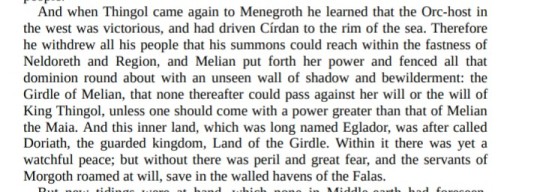
Both Lùthien and Ungoliant help Beren and Melkor in stealing the silmarils, and by help I mean assisting to the point that it is them who seem to be doing most of the actual work. (Beren literally just needs to sit back and watch as Lùthien puts all of Angband to sleep singlehandedly. It is Ungoliant who does most of the actual darkening in the darkening of Valinor, and in an earlier version Ungoliant destroys the Two Trees all by herself. Melkor isn't even there.)
And it's all rather funny looking at this because though they have these similarities they could not be more different. Lùthien is a beautiful elf princess who defeats both Sauron and Morgoth through the power of ✨️True Love✨️ who personally couldn't care less for the silmarils, and Ungoliant is a gigantic hideous demon spider who eats light itself like a black hole and nearly devours Melkor alive when he doesn't give her the silmarils(talk about toxic relationship lol). Lùthien heals, Ungoliant poisons. Lùthien brings Light, Ungoliant brings Darkness(or rather Unlight). Lùthien acts out of love, Ungoliant acts out of selfishness.
They could not be more, completely different. Lùthien is the Anti-Ungoliant. Ungoliant is the Anti-Lùthien. And yet they have these subtle similarities and it drives me insane.
IT'S ABOUT THE SIMILARITIES AND YET STARK CONTRASTS
#There's actually quite a lot of other subtle similarities between the two stories and it fascinates me#Not just in the published silmarillion but in the Book of Lost tales as well#But I simply do not have the energy to write it right now#silmarillion#Tolkien#Luthien#Ungoliant#Beren and Luthien
31 notes
·
View notes
Text
Birds of Doriath (non Songbirds)
I have songbirds of Doriath here and my masterlist of environmental world building here!
Doriath is a region made up of a variety of forests. There is Region, a forest of holly and other mostly deciduous trees, Neldoreth, an ancient beechwood, Nivrim, a forest of primarily oak north of the twilit meres and finally Arthórien, a forest we have almost no information on, divided from the rest of the kingdom by the river Aros which runs along the Eastern border of greater Doriath.
Greater Doriath (Region and Neldoreth): black billed cuckoo, tawny owl, barn owl and subspecies, goshawk, sparrow hawk, wood grouse, common quail, common swift, moorhen (also found in Nivrim), little curlew, red kites, black woodpecker, green woodpecker, hoopoe (in clearings, glades and outskirts),
Nivrim and the twilit Meres: Barrow’s golden eye, ural owl and ural owl subspecies, northern hawk owl, wood duck, water rail, spotted crake, black stork, common golden eye, horned grebe, marsh harrier, tree kingfishers, merlin
Arthórien (markedly different climate): hill partridge, emerald dove, great eared nightjar, kiwi species, black wood pigeon, rain quail, grey headed woodpecker, Japanese scops owl, grass owl, white backed woodpecker, green pigeon, greater painted snipe (I’ll probably make a more thorough post for this entirely)
World building notes:
I’ve talked about this before but common and rain quails are domesticated for their eggs and meat, primarily by the marchwardens! There are little enclosures built in strategic locations between the temporary huts the marchwardens use between scouting and other missions. There are elves, usually younger ones who might be training as a scout or warden, who care full time for the birds. The quails live good long lives and are often named by their keepers. While in Doriath, Túrin saved four quails from being eaten out of spite
Nightjars and owls are considered sacred to the Silvan of Doriath who reside in Arthórien and appear frequently in song and folklore.
Water birds are most commonly found in Nivrim where ponds and marshlands make up part of the ecosystem. Their images appear upon the walls of Menengroth in the passages beneath the river.
Though birds of prey are not reviled by any means, depictions of the deaths of elves in battle or through other violent means are commonly represented as birds of prey killing songbirds
20 notes
·
View notes